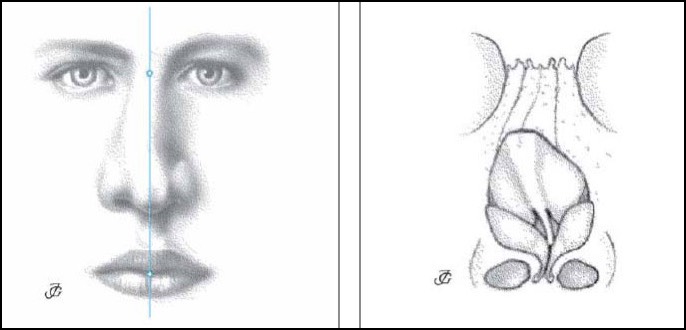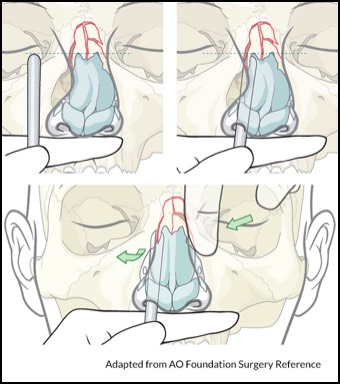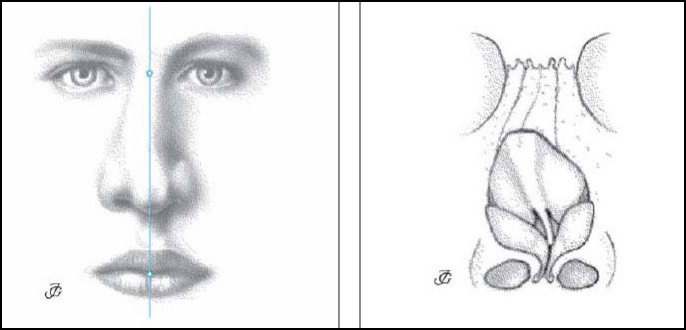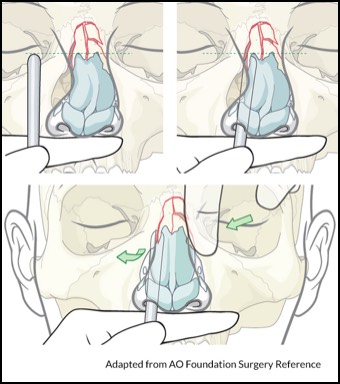Nasal Fracture

I get a LOT of phone calls about kids who have injured their noses - from toddlers who fall down and face plant, to older kids getting hurt playing basketball, baseball, skiing or just roughhousing with their friends. Most of the time, nothing needs to be done for a nasal injury.
But the timeline is VERY important. You have a very short window of opportunity, so don’t miss it. If you see a specialist (like an ENT doc or a plastic surgeon) too soon, they won’t be able to tell if anything needs treatment. If you wait too long, you will miss your chance to make things look better. This article will help you make the right decisions.
Also, it’s important to remember that while the nose injury may be obvious, it’s also possible for the same accident to injure the bone around the eyes, the teeth, or other facial structures. This isn’t about those situations.
You almost never need an x-ray for a simple nasal injury. A plain x-ray or even a CT scan can suggest that there is a fracture that needs treatment, when it’s actually an old, healed fracture. You diagnose a nasal fracture by looking at the nose and feeling it once the swelling has gone down.
There are three possibilities that we need to sort out here - (1) no fracture (break) of the nasal bone, (2) the nasal bone is broken but not “displaced" (pushed off to one side or the other), and (3) a fracture with displacement of the bone. Only a displaced nasal fracture needs early treatment, and that means a “closed reduction”, when the bone is pushed back towards the middle of the face under anesthesia, and protected with a splint during healing. For a non-displaced fracture, the treatment is just avoiding contact sports for two weeks.
The most common sports that result in a nasal fracture that needs a closed reduction are baseball (thrown or batted balls, collisions with other players) and basketball (elbows to the face). In these accidents, force is delivered to the side of the nose. Head on trauma (like after a fall and a face plant) is less likely to result in a need for surgery. It’s also uncommon for very young children (under 5) to require this procedure, since the nose doesn’t stick out very far in this age group.
The only thing that needs to be done on the day of injury is to make sure that there is no “septal hematoma”. This is a collection of blood under the lining of the wall (the septum) in the middle of the nose. This is very rare, but if you miss it and don’t drain it within 24 hours, the cartilage that supports the nose can die and you can end up with a deformity that is very difficult to fix. This is easy to rule out, someone just needs to look in the nose with an otoscope or a strong flashlight. It’s pretty obvious, so you don’t need to see a specialist immediately for this, any doctor or nurse should be able to check for a septal hematoma.
Right after the injury, use cold packs for the first 24 hours, then warm packs. Cold packs limit the swelling, warm packs help the swelling go away. There are a number of ways to do this, but one convenient way is to use a reusable pack that has straps to keep it in place. This can be put in the freezer or the microwave it’s available from BodyMoves on Amazon for about $15.
Around day 3-7, you should see your ENT doctor (or plastic surgeon). By then, the swelling will have gone down, and we can figure out if there is a fracture that needs a closed reduction. You have been looking at your child’s nose for their whole life, so you are probably the best person to say if it has shifted. Your doctor will check for things like tenderness and “raccoon eyes” (blood that tracks under the skin after a nasal fracture). From a planning point of view, this is a good time to do everything that you need to do to arrange for the closed reduction. If you wait too long, even if it’s not too late to do the procedure from a surgical point of vieew, you may not have enough time to get a spot in the operating room, and do all of the necessary medical clearance and insurance precertification in time.
One thing to remember when you call for an appointment is that the person answering the phone may not be aware of all of this. If you call and they tell you that nothing is available for a month, either ask to speak with the doctor or try someone else if that’s not possible. There is no point in seeing someone after it is too late to treat the injury.
Closed reduction is usually done around day 5-12. This is the best time to do the procedure - the bones have started to heal so they are “sticky” and more likely to stay in place when repositioned, but they haven’t healed solidly yet. The procedure is pretty simple, you just push the nose back towards the middle, lining up the bones so that they are straight again. Sometimes you need instruments to do this, sometimes it just pops back into place with pressure from the surgeon’s thumb. A splint is applied after that to protect the nose and help healing. Most children require general anesthesia for this operation.
I remove the splint in about a week, and I always let parents know that there will be some swelling that may take a while to go away. In my experience, no one stares at a child’s nose more than the parent of a child who has had a nasal fracture. If you look closely enough at anyone’s nose, there will always be some subtle irregularities, but these generally settle down over the few months after surgey. The main point of the closed reduction is to get the nasal bones back to the middle of the face so that they heal as straight as possible after the injury.
Sometimes parents are told to wait to see their ENT doc until the swelling has gone down, but they aren’t given more information than that, so they show up 3-4 weeks after the injury, By this time the bones have healed in their displaced position, and it’s too late to do a simple closed reduction. All that can be done at that point is a “nose job” (also known as a rhinoplasty), where the bones are rebroken and then set into position. This is a much more complicated procedure, and generally isn’t done until after age 16.
So remember these steps, and if you have ANY questions, feel free to get in touch with me!


But the timeline is VERY important. You have a very short window of opportunity, so don’t miss it. If you see a specialist (like an ENT doc or a plastic surgeon) too soon, they won’t be able to tell if anything needs treatment. If you wait too long, you will miss your chance to make things look better. This article will help you make the right decisions.
Also, it’s important to remember that while the nose injury may be obvious, it’s also possible for the same accident to injure the bone around the eyes, the teeth, or other facial structures. This isn’t about those situations.
You almost never need an x-ray for a simple nasal injury. A plain x-ray or even a CT scan can suggest that there is a fracture that needs treatment, when it’s actually an old, healed fracture. You diagnose a nasal fracture by looking at the nose and feeling it once the swelling has gone down.
There are three possibilities that we need to sort out here - (1) no fracture (break) of the nasal bone, (2) the nasal bone is broken but not “displaced" (pushed off to one side or the other), and (3) a fracture with displacement of the bone. Only a displaced nasal fracture needs early treatment, and that means a “closed reduction”, when the bone is pushed back towards the middle of the face under anesthesia, and protected with a splint during healing. For a non-displaced fracture, the treatment is just avoiding contact sports for two weeks.
The most common sports that result in a nasal fracture that needs a closed reduction are baseball (thrown or batted balls, collisions with other players) and basketball (elbows to the face). In these accidents, force is delivered to the side of the nose. Head on trauma (like after a fall and a face plant) is less likely to result in a need for surgery. It’s also uncommon for very young children (under 5) to require this procedure, since the nose doesn’t stick out very far in this age group.
The only thing that needs to be done on the day of injury is to make sure that there is no “septal hematoma”. This is a collection of blood under the lining of the wall (the septum) in the middle of the nose. This is very rare, but if you miss it and don’t drain it within 24 hours, the cartilage that supports the nose can die and you can end up with a deformity that is very difficult to fix. This is easy to rule out, someone just needs to look in the nose with an otoscope or a strong flashlight. It’s pretty obvious, so you don’t need to see a specialist immediately for this, any doctor or nurse should be able to check for a septal hematoma.
Right after the injury, use cold packs for the first 24 hours, then warm packs. Cold packs limit the swelling, warm packs help the swelling go away. There are a number of ways to do this, but one convenient way is to use a reusable pack that has straps to keep it in place. This can be put in the freezer or the microwave it’s available from BodyMoves on Amazon for about $15.
Around day 3-7, you should see your ENT doctor (or plastic surgeon). By then, the swelling will have gone down, and we can figure out if there is a fracture that needs a closed reduction. You have been looking at your child’s nose for their whole life, so you are probably the best person to say if it has shifted. Your doctor will check for things like tenderness and “raccoon eyes” (blood that tracks under the skin after a nasal fracture). From a planning point of view, this is a good time to do everything that you need to do to arrange for the closed reduction. If you wait too long, even if it’s not too late to do the procedure from a surgical point of vieew, you may not have enough time to get a spot in the operating room, and do all of the necessary medical clearance and insurance precertification in time.
One thing to remember when you call for an appointment is that the person answering the phone may not be aware of all of this. If you call and they tell you that nothing is available for a month, either ask to speak with the doctor or try someone else if that’s not possible. There is no point in seeing someone after it is too late to treat the injury.

I remove the splint in about a week, and I always let parents know that there will be some swelling that may take a while to go away. In my experience, no one stares at a child’s nose more than the parent of a child who has had a nasal fracture. If you look closely enough at anyone’s nose, there will always be some subtle irregularities, but these generally settle down over the few months after surgey. The main point of the closed reduction is to get the nasal bones back to the middle of the face so that they heal as straight as possible after the injury.
Sometimes parents are told to wait to see their ENT doc until the swelling has gone down, but they aren’t given more information than that, so they show up 3-4 weeks after the injury, By this time the bones have healed in their displaced position, and it’s too late to do a simple closed reduction. All that can be done at that point is a “nose job” (also known as a rhinoplasty), where the bones are rebroken and then set into position. This is a much more complicated procedure, and generally isn’t done until after age 16.
So remember these steps, and if you have ANY questions, feel free to get in touch with me!
